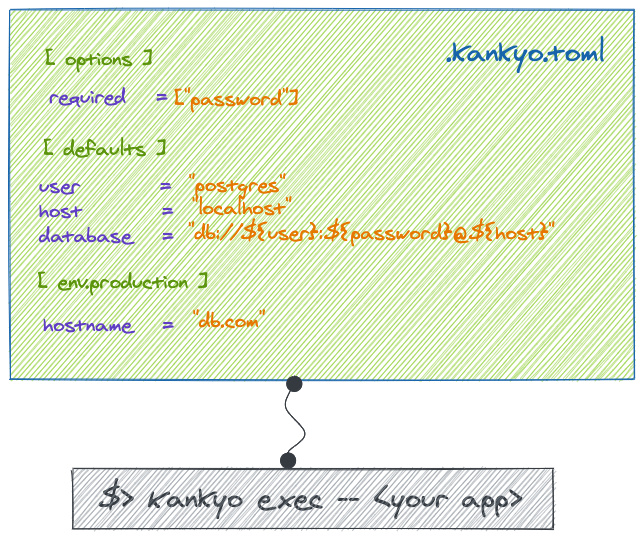Kankyō
環境, かんきょう
An configurable and environment aware .env alternative.
- Getting started
- Usage
- Environment file
- Generating the file
- String interpolation
- Full file example
- Cross-platform
- License
Getting started
Adding to your project
npm install --save kankyo
Installed globally
npm install -g kankyo
With npx
npx kankyo exec -- node app.js
Usage
From the command line
$> npx kankyo --help
Usage: cli [options] [command]
Options:
-q --quiet Quiet mode
-e, --env <env> Specify the environment manually
-f --force If set, will ignore schema/required fields mismatch
-i, --input <file> Specify the environment file
-V, --version output the version number
-h, --help display help for command
Commands:
init
exec
help [command] display help for commandBy using the cli's exec command, followed by your own shell command, Kankyō will load the environment and run the specified command with it.
e.g
npx kankyo exec -- command arg1 arg2 arg3
Programatically
At the earliest stage possible, you can require Kankyō and call its inject method to load up the environment file into the current environment. As you would traditional .env files
e.g
require('kankyo').inject();
console.log(process.env);Fron NPM scripts
Configure your scripts to run anything with Kankyo
{
// ...
"scripts": {
"start": "kankyo exec -- node app.js"
}
}Environment file
Kankyo is configured using a custom TOML file
The default file name is .kankyo.toml
However it also supports the following names as alternatives:
.kankyo.toml.environment.toml.env.tomlkankyo.tomlenvironment.tomlenv.toml
Generating the file
A file can be generated inside your project using the following command:
npx kankyo init
Default Variables
Start by setting the default variables of your environment
[defaults]
hostname = "hello"
database_name = "my_db"Configurable Environments
You can set any number of custom environments, here's an example of us setting a staging environment
[defaults]
# ...
[env.staging]
database_name = "my_staging_db"When run in staging mode, the default database_name will be overridden by the value set under the staging block
Options
-
env_var- Set the variable name that defines which environment is used. Defaults toNODE_ENV -
uppercase- If set, will uppercase all environment variable names. Defaults totrue -
required- An array of variable names which must be provided
Required fields
Under the [options] block, you can add a list of required variables
e.g
[options]
required = ["API_KEY]An exception will be raised if that variable is missing during runtime
> kankyo exec -- <your app>
kankyo:info Kankyo environment file detected: .kankyo.toml +0ms
kankyo:info Loading environment +1ms
kankyo:error Missing environment variables: API_KEY +0msThis forces users to either :
- Add the value to the file (either in defaults or in the environment)
- Add it to the shell environment
> API_KEY=123 kankyo exec -- <your app>
hello world !CI/CD
This feature is particularly useful when dealing with critical variables such as passwords, api keys.
Your CI/CD platform can fill in those keys during deployment, and the error message keeps developers aware when working locally.
String interpolation
Variables defined in the Kankyō file support string interpolation using the "${...}" format.
Example:
[defaults]
word_a = "foo"
word_b = "bar"
sentence = "${word_a} ${word_b}"Full file example
[options]
env_key = "NODE_ENV"
uppercase = true
[defaults]
word_a = "foo"
word_b = "bar"
sentence = "${word_a} ${word_b}"
[env.production]
word_a = "hello"
word_b = "world"Cross-platform
Kankyō is not limited to nodejs projects. The kankyo exec command can run any type of project
Example with Ruby:
Set the env_key option to desired key
[options]
env_key = "RUBY_ENV"
# ...and run your ruby project
RUBY_ENV=development kankyo exec -- ruby program.rb
License
MIT License
Copyright (c) 2021 Patrick R
Permission is hereby granted, free of charge, to any person obtaining a copy of this software and associated documentation files (the "Software"), to deal in the Software without restriction, including without limitation the rights to use, copy, modify, merge, publish, distribute, sublicense, and/or sell copies of the Software, and to permit persons to whom the Software is furnished to do so, subject to the following conditions:
The above copyright notice and this permission notice shall be included in all copies or substantial portions of the Software.
THE SOFTWARE IS PROVIDED "AS IS", WITHOUT WARRANTY OF ANY KIND, EXPRESS OR IMPLIED, INCLUDING BUT NOT LIMITED TO THE WARRANTIES OF MERCHANTABILITY, FITNESS FOR A PARTICULAR PURPOSE AND NONINFRINGEMENT. IN NO EVENT SHALL THE AUTHORS OR COPYRIGHT HOLDERS BE LIABLE FOR ANY CLAIM, DAMAGES OR OTHER LIABILITY, WHETHER IN AN ACTION OF CONTRACT, TORT OR OTHERWISE, ARISING FROM, OUT OF OR IN CONNECTION WITH THE SOFTWARE OR THE USE OR OTHER DEALINGS IN THE SOFTWARE.



